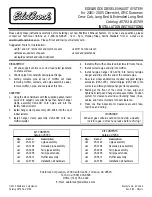
Driving at very high speeds for extended periods of time may result in
damage to vehicle components.
The tires on your vehicle have all-weather treads that provide traction in
rain or snow.
The use of snow cables is not recommended for this vehicle, as damage
to your vehicle may occur under extreme handling or rough road
conditions. However, if you choose to operate the vehicle with snow
cables, avoid these conditions and follow the manufacturer’s
recommendations.
Do not use any type of tire chains, as this will likely cause damage to
your vehicle.
VEHICLE LOADING – WITH AND WITHOUT A TRAILER
This section will guide you in the proper loading of your vehicle and/or
trailer, to keep your loaded vehicle weight within its design rating
capability, with or without a trailer. Properly loading your vehicle will
provide maximum return of vehicle design performance. Before loading
your vehicle, familiarize yourself with the following terms for determining
your vehicle’s weight ratings, with or without a trailer, from the vehicle’s
Safety Certification Label and Tire Label:
Base Curb Weight
– is the weight of the vehicle including a full tank of
fuel and all standard equipment. It does not include passengers, cargo, or
optional equipment.
Vehicle Curb Weight
– is the weight of your new vehicle when you
picked it up from your dealer plus any aftermarket equipment.
Cargo Weight
– includes all weight added to the Base Curb Weight,
including cargo and optional equipment. When towing, trailer tongue load
or king pin weight is also part of cargo weight.
GAW (Gross Axle Weight)
– is the total weight placed on each axle
(front and rear) – including vehicle curb weight and all payload.
REVIEW COPY
2005 Thunderbird
(tbr)
, Owners Guide (post-2002-fmt)
(own2002)
,
Market:
USA_English
(fus)
Tires, Wheels and Loading
130
















































